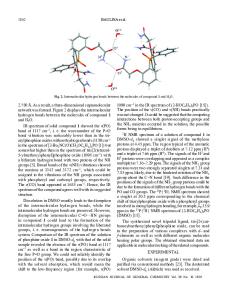Synthesis and Molecular Structure of 2-(4-Chlorophenyl)-3-(phenyl-amino)-5-(thiophen-2-ylmethylidene)-3,5-dihydro-4 H -i
- PDF / 533,229 Bytes
- 4 Pages / 612 x 792 pts (letter) Page_size
- 30 Downloads / 265 Views
TRUCTURE OF ORGANIC COMPOUNDS
Synthesis and Molecular Structure of 2-(4-Chlorophenyl)-3-(phenyl-amino)-5-(thiophen-2ylmethylidene)-3,5-dihydro-4H-imidazol-4-one1 Devinder K. Sharmaa, K. N. Subbulakshmib, B. Narayanab, B. K. Sarojinic, Sumati Anthala, and R. Kanta,* aX-ray
Crystallography Laboratory, Department of Physics, University, Jammu-Tawi, India Department of Chemistry, Mangalore University, Mangalagangotri, D.K., India cDepartment of Industrial Chemistry, Mangalore University, Mangalagangotri, D.K., India *e-mail: [email protected] b
Received July 23, 2016
Abstract—2-(4-Chlorophenyl)-3-(phenylamino)-5-(thiophen-2-ylmethylidene)-3,5-dihydro-4H-imidazol4-one, C20H14N3OSCl was synthesized and its crystal structure was determined by single crystal X-ray diffraction. The crystals are triclinic, sp. gr. P 1 , Z = 2. All three rings are planar, and imidazole ring is almost perpendicular to the phenyl ring with the dihedral angle of 88.65(2)°. In the crystal, pairs of O–H···O hydrogen bonds link molecules into inversion dimers, featuring R22(10) graph set motif. Crystal structure is further stabilized by π···π interactions. DOI: 10.1134/S1063774517070082
INTRODUCTION
EXPERIMENTAL
Imidazole has occupied a unique place in the field of medicines. Imidazole derivatives can be used as fungicides, herbicides and therapeutic agents [1, 2]. The broad medicinal properties of imidazole drugs include anticancer, β-lactamase inhibitors, anti-aging agents, anticoagulants, anti-inflammatory, antibacterial, antifungal, antiviral, anti-tubercular, anti-diabetic and antimalarial [3–8]. The imidazole ring is a constituent of several important natural products, including purine, histamine, histidine and nucleic acid [3, 7]. The high therapeutic properties of the imidazole related drugs have encouraged the medicin chemists to synthesize a large number of novel chemotherapeutic agents incorporating the imidazole nucleus [9]. Imidazole has been used extensively in industry as a corrosion inhibitor on certain transition metals, such as copper [10, 11]. Imidazole in polymers has traditionally been utilized in a variety of applications such as immobilized catalysts [12, 13], redox reactions [14], water purification [15, 16], hydrometallurgy/metal recovery [17, 18], and ion and proton conductors [19]. Imidazolinones show a wide range of pharmaceutical activities such as antimicrobial [20, 21], anti-helmintic activity [22], anticonvulsant [23] and antioxidant activity [24].
Synthesis. A mixture of 2-(4-chlorophenyl)-4(thiophen-2-ylmethylidene)-1,3-oxazol-5(4H)-one (2.89 g, 0.01 mol), and phenyl hydrazine (1.08 g, 0.01 mol) in 30 mL glacial acetic acid were heated under reflux at 120°C for 2–3 h. The reaction mixture was cooled and poured on cold water, the solid mass obtained was filtered off, washed with cold water, and recrystallized from methanol and dimethyl formamide (1:1) mixture. Single crystals were grown from this mixture by slow evaporation (M.P. 509 K–510 K). A schematic reaction scheme is shown in Fig. 1. Crystal structure
Data Loading...











